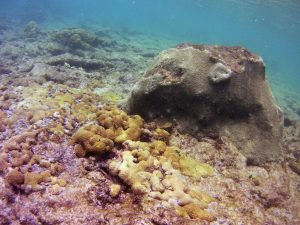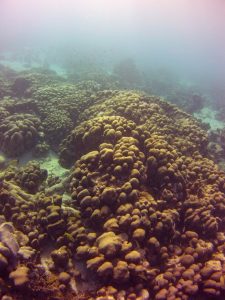John Lewis described the Barbados reefs in 1960:
The coral reefs and coral communities of Barbados, W.I. John B. Lewis. Canadian Journal of Zoology Vol. 38 (1960).
While there has been considerable degradation of nearshore reefs since then (and even before then), his zones for the west coast fringing reefs can still be recognized, as in the figure below, for Vauxhall Reef, beginning inshore with the Reef Flat Zone.

Zones (Lewis, 1960) of the Vauxhall Reef viewed on Google Earth. Zones are placed based on ground observations comparing the physiography and species in place in 2015 to those described by John Lewis in 1960. “D-P” refers to the Diploria-Palythoa zone.
Below I provide extracts from Lewis (1960). I am adding photographs taken 2015-2024 to illustrate the current reef and features described by JBL, also to illustrate some differences from his description.
Except where stated, the photos are from the Vauxhall Fringing Reef, which – at least in my view – is by far the healthiest of the fringing reefs in the MPA. There are components of Lewis’s zones on most or all of the fringing reefs of the MPA, but they may be difficult to find or recognize on the more degraded reefs.
Click on images for larger versions
TEXT BELOW IS EXTRACTED FROM LEWIS (1960)
PHOTOS 2015-2024), BY David P
Reef Flat Zone
A characteristic feature of Barbadian reefs is a wide band of nearly flat reef-rock surface lying between the shore and the zones of actively growing coral. It varies in width from 10 to 70 meters and is on the average about 50 meters wide. It is limited on the inner edge by a sand beach and the shifting of the beaches during periods of heavy seas makes this landward limit very unstable. The outer edge is defined by an increasing irregularity of the bottom and by the appearance of the encrusting coral Diploria clivosa and the colonial
zooanthid Palythoa mammillosa.

Rock overturned in Reef Flat Zone: brittle stars move quickly for cover. Sea urchin is Echinometra lacunter Photo on Apr 4, 2015
It is a shallow area with a depth of no more than 1 foot of water at mean low tide at its inner edge and 1 to 3 feet at its outer limit. The inner edge remains barely wetted at low water spring tides. The bottom consists chiefly of reef debris, flat circular stones, loosely cemented calcareous fragments mixed with sand, or a flat rock pavement. The rock pavement is usually covered with a thick algal turf composed of a filamentous green alga which holds and binds fine sand grains, or the surface may be bare with a coating of pink or purple coralline algae.
Three species of algae regularly achieve attachment in this zone, a Sargassum sp., a Padina sp., and a Dictyota sp. They fasten both to the rock pavement and to the surface of the large boulders. In a few places the turtle grass, Thalasia testudinum, flourishes but this species is not typical of exposed reef flats.

There are some large mounds of Diploria clivosa in the Reef Flat Zone at Vauxhall (pic on Apr 4, 2015), even only 10 m from the beach/ Mean Low Water line – their abundance in the Reef Flat and occurrence this close to shore is not consistent with the description of Lewis (1960).
The only coral which is common on the reef flat is the small encrusting species, Siderastrea radians. Scattered colonies, a few inches in diameter, are common on all reef flats. Stunted colonies of the branching Porites porites occur occasionally in the Thallasia beds. While corals are poorly represented in the reef flat zone, there is often a rich variety of other invertebrates. Beneath the flattened boulders, large numbers of the ophiuroids, Ophiocoma echinata and 0. riisei, occur. Other common forms are the echinoids, Tripneustes esculentus and Echinometra lucunter; the burrowing spatangoid, Brissus brissus; the holothurians, Holo- thuria arenicola, H . parvula, and Stichopus badionotus; the asteroids, Linckia guildingii and Ophidiaster guildingii; the whelk, Thais deltoidea; the hermit crabs, Erpiphia gonogra and Clibanarius tricolor; several species of porcellanid and grapsoid crabs; and ascidians, Bryozoa, sponges, and polychaetes.
Diploria-Palythoa Zone
This zone is characterized by the extensive colonization of two forms, the coral Diploria clivosa and the colonial zooanthid Palythoa mammillosa, and by the increased irregularity of the bottom topography. Low mounds of reef rock and sharp projections appear a t the outer edge of the reef flat zone.The seaward limit of the Diploria-Polythoa zone is more irregular and roughened than the landward limit, and the zone is evidently one in which the rock surface is being eroded and flattened.
The zone varies in width from 5 to 20 meters and is, on an average, about 10 meters wide. At its outer limit it is covered by about 2 feet of water at mean low tide. There are many potholes a few feet deep and winding rubble- filled channels which continue outwards into the seaward edge of the reef. The surface of the zone is slightly higher than the reef flat.
Diploria clivosa is the most successful coral occurring in this zone. It forms low encrustations 1 or 2 f t wide up to 6 f t in diameter. Towards the outer edge of the zone where potholes and other depressions occur, the rock surface is colonized by half a dozen other corals. Porites porites occurs in stunted colonies, and there are flat or rounded encrustations of Porites astreoides. There are also rounded boulders of Diploria strigosa and scattered colonies of Favia fragum and Montastrea annularis. On the sides of the potholes, small irregularly rounded colonies of Agaricia agaricites are encrusted.
The colonial zooanthid, Palythoa mammillosa is very abundant in this zone. Wide sheets, several meters in diameter, are formed or it occurs as small closely adjoining rounded colonies.
The hydroid Millepora alcicornis is often abundant on the rock surface. The colonies are short, stout, and encrusting, or form short blade-like structures. The ubiquitous sea urchin, Diadema antillarum, is abundant in holes and crevices. The large anemone, Stoichadis helianthus, is abundant on some reefs and may form widespread sheets several meters across. These sheets can exclude the settlement of all other organisms. An encrusting alcyonarian, Erythropodium caribaeorum, is often common on the sides of the valleys at the outer edge of the zone.
On all reefs, where the surface is bare of other encrusting forms, the rock is covered by a layer of coralline algae, and small branching clusters of a purple coralline algae are common in crevices.
Reef Crest Zone
The reef crest is a region of prolific coral growth and, in terms of development and succession of corals, it is the climax zone of the living reef. The width of the zone varies from 20 to 100 meters. Its seaward limit is defined as the point at which the profile of the reef begins to slope downwards towards the bottom. Between this point and the outer edge of the previous zone, the reef maintains a more or less horizontal surface 2 to 4 feet below water at mean low tide.
The basic feature of this zone is a series of spurs or ridges which project outwards towards the sea and alternate with irregular winding valleys. The height of these spurs from the bottom is 4 to 6 meters at the outer limit. This formation is similar to that described by Goreau (2) for the buttress zone of Jamaican reefs, and by Newell and Rigby (5) for Andros reefs in the Ballamas. The bottoms of the valleys are composed of sand towards the
outer edge, and debris blocks or fragments at the inner edge where the valleys narrow and merge with the reef rock pavement or become choked with debris.
The spurs, which lie perpendicular to the shore, vary from 3 to 7 meters in width and are irreglar in outline. They are often bisected across their widths to form separate massive blocks. The sides of the spurs are perpendicular but are undercut at their bases. Towards the outer edge of the zone, the walls are composed chiefly of Montastrea annularis which forms shingle- like plates, simple sheet-like faces, or lobular colonies (Figs. 4, 5 , and 6). Siderastrea siderea occasionally replaces Montastrea as the chief component of the sides of the spurs. It does not, however, form vertical faces but rather Iarge rounded masses which bulge outwards from the walls into the valleys.
From mid-zone to the inner edge of the reef crest, large portions of the walls have broken off due to the undercutting at the base, and here the waI1s are sloping and irregular. The walls in t h i s part of the zone are encrusted with a variety of other corals which are established after the breakoff of the walls.
The surface of the zone is approximately horizontal but with deep holes and cavities and sharp projections. This horizontal surface is composed entirely of dead coral rock which has become secondarily encrusted with a number of different species of corals (Fig. 7). Porites porites and Porites asteroides are co-dominant species. The intensity of colonization increases towards the seaward edge where these tvo species cover more than 75% of the rock surface.
The following species occur on the horizontal surface:
| Porites porites Porites asteroides Montastrea annularis Montastrea cavernosa Acropora palmata |
Diploria clivosa Diploria strigosa Diploria labyrinthiformis Favia fragum Sideratsrea siderea |
On the walls of the spurs, except at the outer edge, the following species are found:
| Stephanocoenia michlinii Montastrea cavernosa Montastrea annularis Agaricia agaricites Siderastrea siderea Porites astreoides |
Mycetophyllia lamarkana Isophyllastrea rigida Isophyllia multiflora Eusmilia fstigiata Colophylia natans |
On many reefs this zone is poorly developed. Montastrea annularis often scarce and the spurs are loosely connected, low, and with sparse encrustations of other corals. Wide areas have a n encrustation of pink coralline algae and scattered colonies of Porites porites, but appear otherwise devoid of life.
Not in John lewis’s time: Acropora prolifera “Mother Colony” at the inner edge of the Reef Crest Zone in 2015
Of the other invertebrates found in the reef crest zone, the hydroid Millepora alcicornis is the most common (Fig. 8). It forms clumps of blade-like structures on the surface and grows up to the water level of low water spring tides. Other common forms include the peculiar little anemone Hoplophoria coralligens. This species has two sets of tentacles, one lobate and the other lanceolate. It lives in narrow crevices all over the surface of the rock. The large anemone Stoichactis helianthus occurs on the walls of the spurs and on debris at the bottoms of the valleys, and two other species of anemones, Zooanthus pulchellus and Ricordea florida, are common. The large polychaete Sabellastarte magniJica is common and occurs between the branches of Porites porites. The gastropod Coralliophila abbreviatum is often abundant on partly eroded heads of Montastrea annularis and appears to be one of the agents of surface destruction of this coral.
Seaward Slope
This zone is characterized by a gradual slope of the reef surface from the crest to the bottom at a depth of 5 to 6 meters. At the outer limit, 30 to 150 meters beyond the reef crest, low ridges appear as outcrops 1 to 3 meters high from a sand or rubble bottom. Elsewhere the ridges may be continuous with the reef crest and extend seaward in a gentle slope to the bottom. Near the reef crest, separate massive boulders, 3 to 5 meters in height and 5 or 6 meters in diameter, appear. The ridges are separated by sand bottom (the seaward continuations of the valleys of the reef crest zone) or may be joined by low growths of massive corals. Valleys are less regular in this zone and they tend to divide and form large open patches of sand bottom
The dominant coral in this zone is Montastrea annularis. I t is found not only on the sides of the larger blocks as flat sheets and shingles, but also upon the sides of the low ridges and on top as large clumps of lobular colonies. Siderastrea siderea is also an important structural element of the sides of the crests.
Leading edge of a spur in the fringing reef, in the Seaward Slope Zone. 100% living coral! Photo Apr 1, 2015.
At the inner limit of the seaward slope, the composition of the corals on the ridges is the same as that of the reef crest with several additions. There is a gradual progression outwards, however, to the outer edge where Porites porites and another branching form, Madracis asperula, become codominants. At depths of 5 to 6 meters, pure or mixed stands of these two species cover the lower lying ridges.
The following species are common in the seaward slope zone
| Madracis asperula M. decactis Porites porites P. astreoides Agaricia agaricites Siderastrea siderea Diploria strigosa Diploria labyrinthiformis Colpophyllia natans |
Colpophyllia amaranthus Montastrea annularis Montastrea cavernosa Dendrogyra cylindrus Mussa angulosa Ezismilia fastigiata Isophyllastrea rigida Mycetophyllia lamarckana Isophyllia multiflora |
Reef Front

Individual corals and gorgonians on sand in the Reef Front zone a few meters from the seaward edge of the Seaward Slope. The larger corals are Montasrea annularis, the smaller one at the base of the gorgonid is Porites asteroides. Photo on May 7, 2015
As the forward edge of the seaward slope decreases in height, the low ridges disappear and are replaced by scattered patches of coral heads. A band of sand and rubble bottom, which is dotted with these patches, lies along most of the leeward coast at depths of about: 0 to 10 meters. The density of the patches varies widelv from place to place.
The dominant coral of this zone is agnin M. annularis, If forms groups of lobular colonies and is the chief structural base for the settlement of other species of corals. The clumps reach x height of about 4 feet and vary from 2 to 8 feet in diameter.
Associated with M. annularis are Diploria strigosa, Diploria labyrinthiformis, Porites porites, Meandrina mcandrites, M. brasiliensis, Dichccoena slokesii, Siderastrea siderea, Agaricia agaricites, and A. fragilis, and Porites asterooides. Siderastrea siderea, sometimes replaces Montastrea annularis as the primary colonizer. Dichocoenia and Meandrina meandrites are very successful on this zone although they do not form large
colonies. They do not occur in the seaward slope zone and are indicator species for the Reef Front. M. meandrites is able to develop directly upon a sand or rubble bottom.
A number of other invertehrntcs arc characteristically found associated with the scattered clunps.The hydroid Millepora alcicornis forms cncrustations on many of the clumps, hut it is low and stunted and never of the blade-like form. The echinoid Diadema antillarium is abundant and the anemones Aiptasia annulata and Condylatis gigantea are found in nearly every group. Several species of gorgonids arc common, and the sponges Desychalina cyathina, Verognia fistularis and Sphecjospongia vesperia. The crustaceans Stenorynchus seticornis and Stenopus hispidis are often c1oseIy associated with Diadema, and burrowing in the sand around the base of the rocks is the synaptid holothurian , Euapta lappa. Thc large holothurian, Holothuria mexicana, occurs on the surface of the sand.
Deep Water Communities
The bottom communities of corals from depths of 10 meters outwards to the limit of the investigations at about 30 rncters is an extremely rich one. There are not only extensive mixed stands of coraIs, hut there is a great diversity of species of corals and of other invertebrates,.Two types of communities are present: pure stands of Maracis asperula (mixedwith Porites porites at shallower depthss, and mixed stands of nearly two dozen coral species.
Madracis asperula is normally a deep water species. It has been dredged from depths of 50 to 100 fathoms locally on several occasions. The shallow- water form on the Barbados reefs is, however, a stout-branched form. The branches grow upright and arc close together. The polyps are extended during the daytime and the surface of living tifssue evtcnds for about 1 inch downwards from the tip o f the branch. Below the growing area, the branches are covered 1140 with coralline algae and sponges which bind the dead branches together. In deeper water this base of sponge-bound branches reaches thicknesses of 2 or 3 ft.
Extensive beds of Madracis asperula occur as almost pure stands from depths of about 10 meters. The closely packed branches form a complete covering, interrupted by patches of other corals or Madracis rubble to depths of at least 30 meters.
The interstices between dead branches support a rich invertebrate fauna. The ophiuran, Ophiothrix suensonii, is abundant on the surface of the coral or between the ends of the branches. Several other species of ophiurans occur deeper within the crevices. Two starfish, Ophidiaster guildingii and Linckia guildingii, are common, and there is a small synaptid holothurian. There is an abundant microfauna including gastropods, pelecypods, small crabs, annelids, amphipods, isopods, and alpheid shrimp. The unbranched gorgonid,
Briarum asbestinurn is a characteristic feature of the Madracis beds as is the large yellow tubular sponge, Verongia jistularis. Several species of comatulid crinoids are also common.
Alternating with the Madracis beds are stands of mixed corals. In these
stands are found more than half the species of corals occurring in Barbados.
A list of the species and their relative abundance in the community is shown
below (A abundant, C common, R rare):
| Montastrea annularis A Montastrea cavernosa A Siderastrea siderea A Diploria strigosa C Diploria labyrinthiformis C Agaricia agaricites C Agaricia nobilis C Agaricia fragilus R Acropora cervicornis C Mussa angulosa C Eusmiliu fastigiata C Porites porites A |
Porites astreoides C Porites furcata C Madracis asperula A Madracis decactis C Colpophyllia natans C Colpophyllia amaranthus C Mycetophyllia lamarckana C Isophyllustrea rigida C Dichocoeniu stokesii R Meandrina meandrites C Favia fragum C Dendrogyra cylindrus R |
This mixed community alternates with beds of Madracis asperula. The community never achieves substantial height, but forms rather a low cover over the bottom. Rounded heads of M. annularis reach a height of 1 or 2 ft, while A . cervicornis reaches 3 or 4 ft.
In addition to the variety of species present, a striking feature of this community is the intensity of the colonization. The bottom at deeper levels is almost completely covered by living coral. Massive and encrusting species such as Montastrea, Siderastrea, and Colpophyllia grow on the substrate while Porites and Acropora grow up from crevices and form a branching network above the massive species.
The other invertebrate fauna of this mixed community is also rich and varied. Perhaps the most striking animals of the community are the ophiuroids. These occur on almost foothold, clinging to sponges and gorgonids and festooned on the branches of the corals. The glassy spined Ophiothrix suensonii is the most common, but several other species occur in the crevices a t the base of the corals. The unbranched gorgonid, Briarium asbestinum, is very common as are several branching forms. The anemones Aiptasia annulata and Condylactis gigantea are common. A simple unbranched antipatharian
occurs at deeper levels. Millepora alcicornis is abundant and forms delicately branching structures as well as knotted encrustations on the branches of dead corals. Several species of comatulid crinoids of the genus Nemaster are common.

